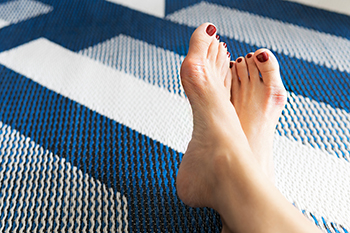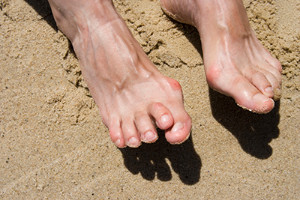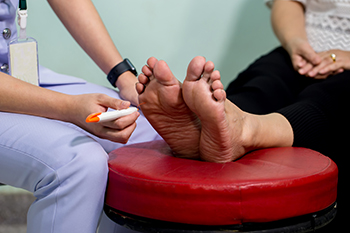
Dr. Kenneth Rosenthal
Dr. Jonathan C. O’Quinn
Dr. Michael J. Price

Dr. Kenneth Rosenthal
Dr. Jonathan C. O’Quinn
Dr. Michael J. Price
 Bunions are bony bumps that form on the joint at the base of the big toe, resulting from the misalignment of the foot's bones. This misalignment causes the big toe to lean toward the second toe, rather than pointing straight ahead, which creates a visible protrusion on the side of the foot. Bunions can cause pain, soreness, and swelling, especially when wearing tight-fitting shoes that press against the bump. There are conservative treatments for less severe cases, such as wearing wider and more comfortable shoes that provide ample space for the toes, and using padded shoe inserts to distribute pressure evenly across the foot. Special exercises that strengthen the foot and improve flexibility can also help manage bunion symptoms. These non-invasive treatments aim to relieve discomfort and prevent the progression of the bunion without the need for surgical intervention. However, more severe cases of bunions may warrant surgery. If you have a bunion, it is suggested that you schedule an appointment with a podiatrist to discuss treatment and measures you can take to prevent the condition from worsening.
Bunions are bony bumps that form on the joint at the base of the big toe, resulting from the misalignment of the foot's bones. This misalignment causes the big toe to lean toward the second toe, rather than pointing straight ahead, which creates a visible protrusion on the side of the foot. Bunions can cause pain, soreness, and swelling, especially when wearing tight-fitting shoes that press against the bump. There are conservative treatments for less severe cases, such as wearing wider and more comfortable shoes that provide ample space for the toes, and using padded shoe inserts to distribute pressure evenly across the foot. Special exercises that strengthen the foot and improve flexibility can also help manage bunion symptoms. These non-invasive treatments aim to relieve discomfort and prevent the progression of the bunion without the need for surgical intervention. However, more severe cases of bunions may warrant surgery. If you have a bunion, it is suggested that you schedule an appointment with a podiatrist to discuss treatment and measures you can take to prevent the condition from worsening.
If you are suffering from bunions, contact one of our podiatrists of Eastern Carolina Foot & Ankle Specialists. Our doctors can provide the care you need to keep you pain-free and on your feet.
What Is a Bunion?
A bunion is formed of swollen tissue or an enlargement of boney growth, usually located at the base joint of the toe that connects to the foot. The swelling occurs due to the bones in the big toe shifting inward, which impacts the other toes of the foot. This causes the area around the base of the big toe to become inflamed and painful.
Why Do Bunions Form?
Genetics – Susceptibility to bunions are often hereditary
Stress on the feet – Poorly fitted and uncomfortable footwear that places stress on feet, such as heels, can worsen existing bunions
How Are Bunions Diagnosed?
Doctors often perform two tests – blood tests and x-rays – when trying to diagnose bunions, especially in the early stages of development. Blood tests help determine if the foot pain is being caused by something else, such as arthritis, while x-rays provide a clear picture of your bone structure to your doctor.
How Are Bunions Treated?
If you have any questions, please feel free to contact our office located in Greenville, NC . We offer the newest diagnostic and treatment technologies for all your foot care needs.

Athlete’s foot, or tinea pedis, is a common fungal skin infection. It can be recognized by raw, cracked, or scaly skin, affecting the skin between the toes. Other symptoms of athlete’s foot are redness, itching, and in some cases, a burning sensation. Athletes’s foot can happen to anyone who comes into direct contact with infected skin or contaminated surfaces, like bathroom floors and towels. Factors such as moist, sweaty feet, skin damage, and weakened immune systems increase susceptibility. For persistent or severe cases, a podiatrist can provide a tailored treatment plan to effectively manage athlete’s foot and prevent recurrence. If you have developed athlete’s foot, it is suggested that you schedule an appointment with a podiatrist for an exam and prescribed medication.
Athlete’s Foot
Athlete’s foot is often an uncomfortable condition to experience. Thankfully, podiatrists specialize in treating athlete’s foot and offer the best treatment options. If you have any questions about athlete’s foot, consult with one of our podiatrists from Eastern Carolina Foot & Ankle Specialists. Our doctors will assess your condition and provide you with quality treatment.
What Is Athlete’s Foot?
Tinea pedis, more commonly known as athlete’s foot, is a non-serious and common fungal infection of the foot. Athlete’s foot is contagious and can be contracted by touching someone who has it or infected surfaces. The most common places contaminated by it are public showers, locker rooms, and swimming pools. Once contracted, it grows on feet that are left inside moist, dark, and warm shoes and socks.
Prevention
The most effective ways to prevent athlete’s foot include:
Symptoms
Athlete’s foot initially occurs as a rash between the toes. However, if left undiagnosed, it can spread to the sides and bottom of the feet, toenails, and if touched by hand, the hands themselves. Symptoms include:
Diagnosis and Treatment
Diagnosis is quick and easy. Skin samples will be taken and either viewed under a microscope or sent to a lab for testing. Sometimes, a podiatrist can diagnose it based on simply looking at it. Once confirmed, treatment options include oral and topical antifungal medications.
If you have any questions, please feel free to contact our office located in Greenville, NC . We offer the newest diagnostic and treatment technologies for all your foot care needs.

If one of your toe joints points upward instead of lying flat, it might indicate a condition known as hammertoe, where weakened toe muscles exert pressure on tendons and joints. This deformity can hinder walking and limit certain activities. Early intervention and preventive measures can help to avoid complications. Hammertoes affect the proximal interphalangeal joint, or PIPJ, causing the middle joint to flex upward. Ill-fitting shoes, especially those with narrow fronts or high heels, commonly trigger this condition. Rheumatoid arthritis or bunions can also contribute. Treatment includes wearing properly sized shoes and using splints or orthotic inserts. Surgery may be necessary for severe cases. Home exercises like toe stretches can help alleviate symptoms. Prioritize footwear comfort to prevent hammertoes and bunions from forming due to prolonged pressure on the toes. If you have a hammertoe that is causing you discomfort, it is suggested that you make an appointment with a podiatrist for an examination and relief methods.
Hammertoes can be a painful condition to live with. For more information, contact one of our podiatrists of Eastern Carolina Foot & Ankle Specialists. Our doctors will answer any of your foot- and ankle-related questions.
Hammertoe
Hammertoe is a foot deformity that occurs due to an imbalance in the muscles, tendons, or ligaments that normally hold the toe straight. It can be caused by the type of shoes you wear, your foot structure, trauma, and certain disease processes.
Symptoms
Risk Factors
Treatment
If you have hammertoe, you should change into a more comfortable shoe that provides enough room for your toes. Exercises such as picking up marbles may strengthen and stretch your toe muscles. Nevertheless, it is important to seek assistance from a podiatrist in order to determine the severity of your hammertoe and see which treatment option will work best for you.
If you have any questions, please feel free to contact our office located in Greenville, NC . We offer the newest diagnostic and treatment technologies for all your foot care needs.

Living with diabetes brings a multitude of challenges, with one often overlooked aspect being the health of your feet. Diabetes can lead to significant complications in foot health, including ulcers, nerve damage, and infections. Uncontrolled diabetes can cause nerve damage, resulting in reduced sensation in the feet, which is a condition known as diabetic neuropathy. This loss of feeling can indicate that minor injuries or irritations may go unnoticed, and increases the likelihood of them turning into more severe problems like ulcers. Additionally, diabetes can damage the arteries supplying the nerves, furthering nerve damage and impairing circulation. Regular foot checks by a podiatrist are essential for individuals with diabetes. These visits will monitor foot health, identify early signs of complications, and guidance will be received on proper foot care techniques. If you have foot problems that may be the result of diabetes, it is suggested that you schedule regular visits to a podiatrist who is medically trained to manage this condition.
Diabetic foot care is important in preventing foot ailments such as ulcers. If you are suffering from diabetes or have any other concerns about your feet, contact one of our podiatrists from Eastern Carolina Foot & Ankle Specialists. Our doctors can provide the care you need to keep you pain-free and on your feet.
Diabetic Foot Care
Diabetes affects millions of people every year. The condition can damage blood vessels in many parts of the body, especially the feet. Because of this, taking care of your feet is essential if you have diabetes, and having a podiatrist help monitor your foot health is highly recommended.
The Importance of Caring for Your Feet
Patients with diabetes should have their doctor monitor their blood levels, as blood sugar levels play such a huge role in diabetic care. Monitoring these levels on a regular basis is highly advised.
It is always best to inform your healthcare professional of any concerns you may have regarding your feet, especially for diabetic patients. Early treatment and routine foot examinations are keys to maintaining proper health, especially because severe complications can arise if proper treatment is not applied.
If you have any questions please feel free to contact our office located in Greenville, NC . We offer the newest diagnostic and treatment technologies for all your foot and ankle needs.